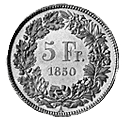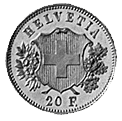Swiss money
Swiss monetary history began about 200 BC, first with Celtic, later with Roman coins. A great variety of one-sided pennies (so-called bracteates)were issued by different secular ans ecclesiastic authorities at the beginning of the Medieval Age in Zurich, Bern, Basel, Schaffhausen, St. Gallen and other places. Large silver coins were first minted around the year 1490 in Bern, at the beginning of the 16th century also in Fribourg, Solothurn, Basel, Lucerne and Zurich, that were originally called guldiner and later taler.


Zürich, Guldiner 1512 (left); St. Gallen, Taler 1563 (right)
The 75 different coining authorities that had the right to mint coins in the area encompassing today's Switzerland created an unendingly complicated coinage system. In the middle of the 19th century the coins circulating in Switzerland amounted to a value of 115 million francs. Of these, only 10% came from the geographical area of Switzerland. However, since each independent city or canton had its own privilege of coinage, there were about 860 different coin types in circulation.



Luzern, 10 Franken 1804 (left); Thurgau, 1/2 Batzen 1808 (front and back)
The federal state founded in 1848 put an en to this confusion. Article 36 of the federal constitution stated that the coinage of the different authorities was to be terminated and that the right of coinage remained solely with the federal government.


Eidgenossenschaft, 5 Franken 1850 (front and back)
In 1865 the Latin Monetary Union was created.. France, Belgium, Italy, Greece and Switzerland agreed on silver and gold coins of uniform weight and fineness in order to simplify the exchange of their currencies. Mounting economic problems and the constant re- or devaluation of certain currencies brought an end to this union in the beginning of the 20th century.

Eidgenossenschaft, 5 Franken 1894


Eidgenossenschaft, 20 Franken 1871 (front and back)
In 1871 the Federal Council allowed the mintage of a number of pattern gold coins. Since the minting of these gold coins created a deficit, the definite issue of Swiss gold coins did not come until 1883. From 1883 until 1896 20 franc pieces with the head of Helvetia were minted. The "Vreneli"at 10 francs was issued from 1911 until 1922, the 20 franc issue from 1897 until 1949. 5000 coins with a nominal value of 100 francs were issued in 1925. From 1968 to 1969 Swiss silver coins were withdrawn from circulation and replaced with coins made out of a copper-nickel alloy. The commemorative issues that had been minted from 1936 to 1963 in silver were also mined in copper-nickel from 1974 on. In 1991 commemorative coins in gold and silver at 250 and 20 francs were issued on the occasion of the 700 year celebration of the Swiss Confederation. In 1998 gold and silver coins were once more issued in commemoration of the 200 years of the Helvetian Republic. The coin depicts a window showing the coin themes prevalent on coinage of the time.


Eidgenossenschaft, 100 Franken 1925 (front and back)


Eidgenossenschaft, 100 Franken 1998/Jubilee Bundesstaat (left); Eidgenossenschaft, 100 Franken 1998/Jubilee Helvetic republic (right)